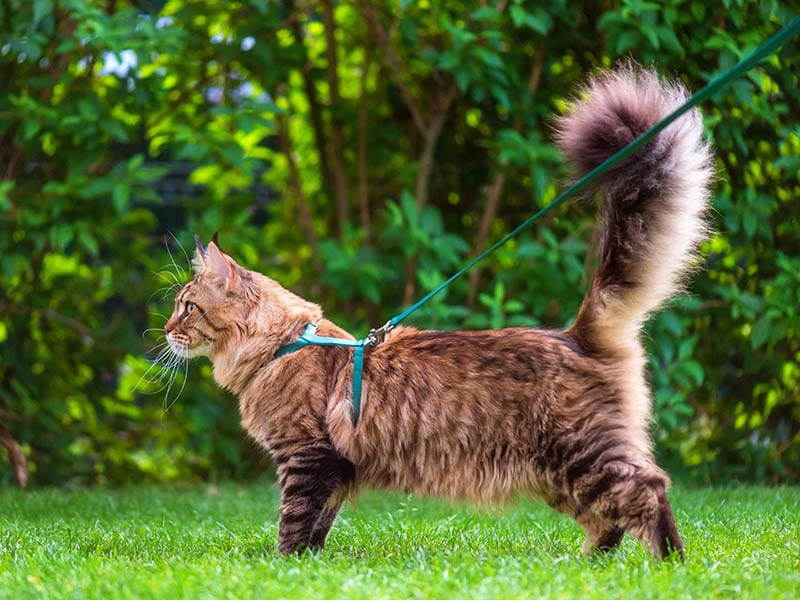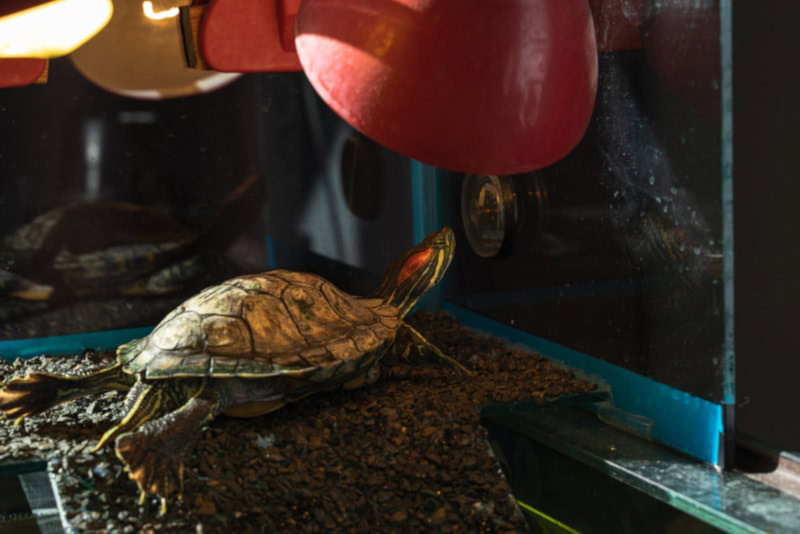VET APPROVED

The information is current and up-to-date in accordance with the latest veterinarian research.
Learn more »Click to Skip Ahead
If you have a cat, you might have wondered whether it is cruel to make them wear a leash. Since cats are perceived as independent creatures that like to wander around and explore, it is understandable that you don’t want to restrict their curious nature in any way. But it can be dangerous for cats to roam free outside, and leashes can be helpful if you need to keep your cat safe in certain situations.

Is it Cruel to Make a Cat Wear a Leash?
Opinions on whether leash walking is cruel for cats are divided. It could be considered cruel if your cat is severely distressed on a leash. If your cat enjoys leash walks, it would not be considered cruel to have them wear a leash. The biggest argument against leash-walking cats is that it deprives them of their natural ability to run, climb, jump, and hide from stressors that they may encounter. However, these natural abilities may also get them in trouble when they’re outdoors, which may justify the use of a leash in certain circumstances.
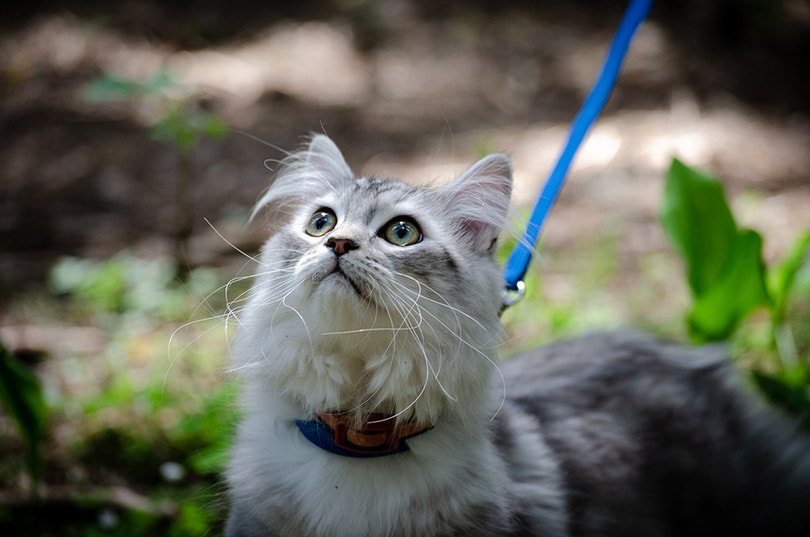
Leash Training and Animal Welfare
Interestingly, while animal welfare organizations in North America recommend leash training cats for safety purposes, U.K. organizations are recommending against it in specific instances. The RSPCA advises cat owners to not leash their cats if it causes them distress. It suggests that cats should be sufficiently stimulated in an indoor environment, with no need to take them outside. However, the FECAVA (based in Europe) does recommend outdoor exposure for pet cats as part of their enrichment and claims that “[c]ats living strictly indoors can get bored and consequently even develop some related health issues.” 1
While some cats are perfectly happy to spend their life indoors, this isn’t true for all cats. Many cats whine at doors or windows to go outdoors, and leash training is one way that owners can satisfy their cat’s need to explore and avoid destructive behavior caused by boredom. For cats whose owners don’t have an outdoor enclosed space (or a yard to put one in), leash training is the easiest way to take cats outside.
Finding a great cat harness can be tricky. Our favorite is Hepper's Cat Harness & Leash Set, which includes a soft, adjustable velvet harness and a premium climbing rope leash. With safety features like quick-release buckles, reflective stripes, and reinforced stitching, you'll love this machine-washable harness as much as your cat will! At PangoVet, we've admired Hepper for many years, and decided to take a controlling ownership interest so that we could benefit from the outstanding designs of this cool company!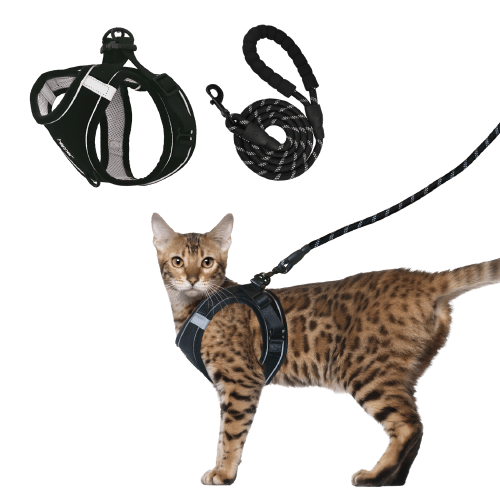

Pros & Cons of Leash Training a Cat
There is no definitive answer to how well your cat will take to leash training — it ultimately depends on your cat’s personality. Some cats may enjoy being outdoors on a leash, while others may find the whole experience stressful. If you’re unsure whether a leash training program is right for your cat, research different training methods and consult your veterinarian for advice.
There are potential benefits to leash training a cat, including:
- It provides indoor cats with extra exercise.
- It enables cats to get fresh air and explore under supervision.
- Leashes keep cats safe and avoid interactions with predators or traffic.
- Leash walks can be a great opportunity to bond with your cat.
The cons of walking your cat on a leash include the following:
- It exposes them to dangers, like off-leash dogs.
- There’s a risk of your cat escaping their harness and fleeing.
- Cats may attempt to flee by climbing a nearby tree or light post, endangering you in the process.
- Cats are territorial by nature and can become stressed in unfamiliar situations.
- The idea of being restrained stresses many cats.
Why Cats Might Not Be Happy About Leash Training
There are a few reasons that some cats are unhappy with the idea of leash training. Cats are notoriously independent creatures, so they often don’t take kindly to being tethered. Additionally, cats like to climb and jump while they explore the world; a leash may make them feel restrained and unable to explore the way that they would like. Finally, some cats, especially older ones, don’t like new experiences or change. This makes leash training stressful for them and an experience that they would rather avoid.
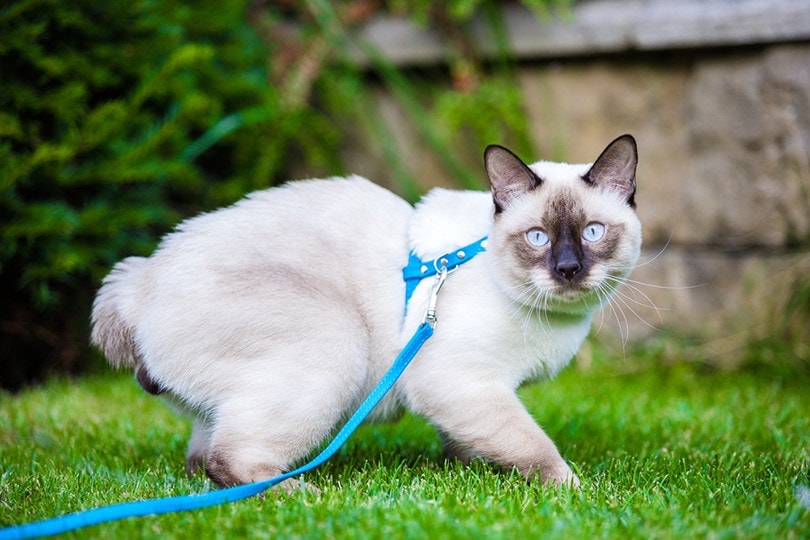
What to Do If Your Cat Doesn’t Like Wearing a Leash
As with most training, the best way to succeed with getting your cat used to a leash is to start their training as a kitten. The younger an animal is when exposed to new things, the easier they take to them. Since this isn’t always possible, especially if you’ve adopted an older cat, there are a few things that you can do to make the process more enjoyable.
- Acclimate your cat to the leash by allowing them to drag it around the house for short periods. This gets them used to the feel of the leash and helps them associate it with positive experiences.
- Start your training at home, in a familiar environment, before venturing outdoors.
- Play with your cat while they are on a leash, as it will help associate the leash with fun times.
- Use a comfortable collar or harness that fits your cat properly. In most cases, it’s safer and more comfortable for your cat to use a harness rather than attaching a leash to a collar.
- Carry treats with you when walking outside as a reward.
- Keep the time spent on the leash short at first, and always end the training session on a positive note.
That said, no one can make a cat do anything that they don’t want to do. If your cat is averse to leash training and it’s causing them obvious distress, you can’t force it. Some cats require a great deal of time and patience to leash train but eventually do take to it. Others love leash walking right away, and some cats just don’t have any interest in going outside at all. It all depends on the cat’s individual personality.
If you choose to leash train, your success will depend on your cat’s preference and yours.

Final Thoughts
There are pros and cons to making a cat wear a leash, but it’s not cruel to do so if your cat enjoys it. There are several advantages to leash training your cat, as it gives you a safe way to take your cat on outdoor adventures. If your cat enjoys spending time outside, leashing them is the best option, but it’s a difficult learning curve for some cats. If your cat isn’t impressed with wearing a leash, there are a few other options for providing them with mental and physical stimulation!
Featured Image Credit: DenisNata, Shutterstock
